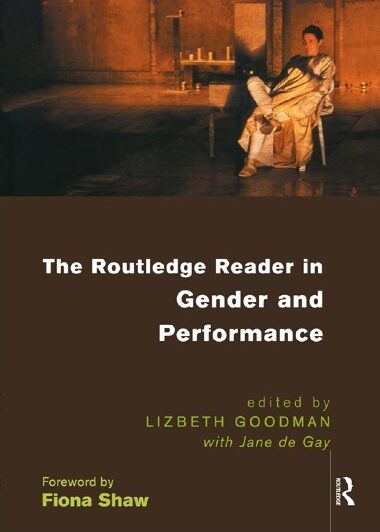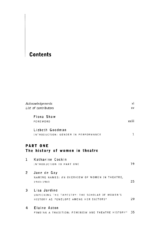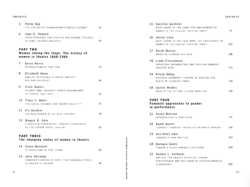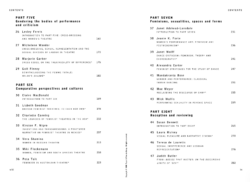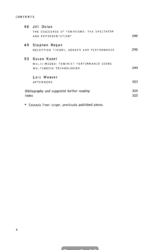Chapter 21
Introduction to Part Four: “What Do Women Want (in Theatre)?”
Susan Melrose
“What do women want (in and of theatre)?” These questions are bound up in wider issues of women’s roles and work in the types of representation with which live theatre and dramatic writing differently engage, including: self-identity; the identity of women as a cultural and/or political grouping; the nature of gender-identities themselves; the specificities of theatre and theatricalities; and the relationship of writing to theatrical presentations and representations.
There is no easy political resolution— ‘we’ are damned if ‘we’ do ‘act like women’, damned if we don’t. But how do ‘we’ act like women (in theatres), if acting is indeed one aspect of a ‘patriarchal’ institution; which, if it has a determining role, must also have determined our perceptions and modes of (theatrical) representation of ourselves? Who will be ‘our’ audience? Might our audience be ‘only’ other women. As Philip Auslander has recently pointed out, in performance ‘the self is gender-amorphous, holding within itself the potential for many different and changing gender and sexual identities’. Hence, I applaud an intervention which is now part of theatre’s feminist history. Gayle Austin (Chapter 22) suggests that ‘we’ should pay attention ‘when women appear as characters and notice when they do not… taking nothing for granted’, because the dominant cultural conventions do not represent ‘the point of view of women’. What is this ‘point of view of women’ in the theatre? Who might determine and represent it? In theatrical terms, point of view is both literal (directors, like actors and spectators, view from specific places in the theatre space) and metaphoric: attitude, ethos and ‘judgements of taste and value’ (Pierre Bourdieu) inform ways of seeing the stage, the performer, character and meaning. Are these factors gender-specific? Do ‘we’ indeed look like women—which seems to mean not looking as men do—in theatre? I might have once wanted, in political terms, to agree without hesitation, but in more general terms I am no longer so sure.
In the act of reading, I suspect that we seek and locate identificatory triggers, which, once activated, cause us all to bring into play rather larger politically dramatic scenarios, relating to how we see and represent ourselves. But who has sewn those triggers, and according to what institutionalized logic/s? I want to suggest that, contrary to certain political assertions, the institutions of theatre are not innately patriarchal. They are institutional—no more, no less—in Michel de Certeau’s understanding of the term as a self-perpetuating, complex structure, through which dominant ideologies can be projected, and which can be and has been, at certain historical moments, appropriated by dominant groups; but which is not identical to that persuasion or ownership, Aristotle institutionalized the tragic poets and projected through this institution then-prevalent attitudes to men, women and ‘slaves’. The institution which controlled text-production and staging in the Ancient Greek context, can no longer be considered to be commensurable with the text’s potential for theatrical reappraisal and reappropriation in different political frames in the late twentieth century. Theatricality is deferred, in Derrida’s sense of the term (I978)—that is, its dramatic component is encoded ‘in writing itself’. Then, theatricality is already the carrier of the enabling conditions of ideological enquiry, rather than the enquiry (or the ideology) itself. That enquiry relates to how we differently interpret, at different times, speaking and the spoken, being seen/not seen, showing/not showing, being present/absent.
It is clear that dramatic meta-codes organizing certain aspects of stage action continued throughout history to be largely male-originating and gendered, such that woman as character is directly informed by historically specific ideologies. In these terms, the strength of the actor and the director is overlaid upon the dramatic logic of the playwright, so that the two both exposing historical injustices in the tiny interstices thereby formed.
Chapter 37
Introduction to Part Seven: “Feminisms, Sexualities, Spaces and Forms”
Janet Adshead-Lansdale
Part seven is first about the ‘pluralism’ of contemporary culture, framed by a ‘postmodern’ analysis of the plurality of perspectives that co-exist. Collectively these practices deny that there could be only one ‘feminism’, or one theory of ‘gender and performance’ or one type of theatre. The tentacles of postmodernism enfold the act of ‘reading’, deliberately fostering gender ambiguity. Nevertheless, women’s intrusion into the male-dominated discourse of modernism allies feminism with postmodernism in a challenge to the status quo. Second, this chapter generates critical debate on the ‘overt and covert forms of misogyny in which discourses participate’.
‘Theatre’ today has moved far beyond the ‘acting’ of ‘plays’ to draw on a much wider range of spaces and forms of interaction, including ‘live art’ and ‘multimedia’ work. The question, ‘but is it art?’ arises from forms which now encompass the ‘performance’ of the self in everyday behaviour and social events. The idea of performance as a multiplicity of practices and theories is exemplified in Mick Wallis’ (Chapter 43) other ‘selves’. From its marginal position the sado-masochistic self generates radical playfulness. That of women’s marginalization, the danger is that while the participants enjoy their ‘play’, they reinforce master/slave, male/female binaries. More recent nude performance by Carolee Schneemann to which Jeanie Forte refers (Chapter 38) attempts to disrupt status quo positions by placing an actual woman at the centre. Karen Finlay challenges through a monologue, acting out sexual situations in extremely forceful language to convey men’s vulnerabilities as well as their arrogant assumptions of superiority. These contemporary performance practices can be understood through the writings of feminist theorists Julia Kristeva and Helene Cixous whose writings can be difficult but are well worth exploring for the intellectual explanations they offer for a playful approach which coerces the reader into re-considering her/his position.
Chapter 49
“Reception Theory, Gender and Performance”
Stephen Regan
From the 1960s onwards, the focus of attention in literary and cultural studies shifted decisively towards the role of the reader or audience in the process of interpretation. The reader came to be seen not as the passive recipient but as the active producer of meaning. The idea of the text underwent a similar transformation: structure with plural and perhaps indeterminate meanings. Feminism, psychoanalysis, structural linguistics and cultural materialism all contributed to this shift of emphasis, but much of the impulse came from a set of critical interests and practices commonly referred to as ‘reader-response criticism’. Reader-response criticism and reception theory are principally concerned with the kinds of reader that various texts seem to imply; with the codes and conventions to which readers refer in making sense of texts; with the mental processes that occur as readers move through a text; and with the sociological and historical differences that might distinguish one response from another. Until recently, reception theory has also been characterized by its seeming reluctance to engage with questions of gender and by its curious lack of interest in drama and performance. The insights and methodologies that have helped to transform reception theory in recent years have come not from literary theory but from film studies and the visual arts. Laura Mulvey’s work (Chapter 45) has been crucially important, both in identifying the sources of pleasure in cinematic art and in recognizing the conventions of mainstream film which stimulate and direct the pleasurable experiences of an audience. Drawing on Freudian and Lacanian theory, Mulvey distinguishes between the erotic pleasure derived from seeing another person as an object of sexual stimulation and the narcissistic pleasure that accompanies the spectator’s identification with other people. She makes a further distinction between the active male gaze and the passive female gaze. The way forward for Mulvey is to break with the traditional film conventions and cinematic codes which create a particular kind of gaze, so freeing the look of the audience into that heightened Brechtian state that she memorably describes as ‘passionate detachment’.
What happens, though, if a woman is the object of another woman’s erotic contemplation? Teresade Lauretis (Chapter 46) attempts to answer this question, and in doing so takes issue with some of the fundamental assumptions of Freudian psychoanalysis, including its preoccupation with sexual difference. Drawing on the work of Luce Irigaray, she argues against those unhelpful and unproductive discussions of gender in which women are defined in terms of their difference from men. Lesbian film criticism, she suggests, might develop its own interpretive strategies; it might redefine, for instance, who is the film’s protagonist or object of desire. There are clearly limits, however, to this ‘oppositional appropriation’ of dominant modes of representation. The alternative might be to establish new forms of representation, new conventions directed to a specific spectator who lies outside the normative heterosexual field of vision. If de Lauretis exposes some of the shortcomings of Freudian psychoanalysis, she also takes feminist theory to task for its occasional blind spots and simplifications, and she calls for a more alert and inquiring response to the relations of desire and meaning in modern culture.
For Judith Butler (chapter 47), sexual difference is a social construction, underpinned by the regulatory discourses that govern our sexual behaviour. Her methodology owes much to Michel Foucault and Jacques Derrida, especially the insistence that discourse produces the effects it names. Butler claims that ‘bodies never quite comply with the norms by which their materialization is impelled’, and that what keeps’ the norm of sex’ in public view is its continual ‘citation’. This citing of the conventions of authority can be regarded as a kind of performance, imposing an oppressive set of regulations on its listeners.
Jill Dolan’s materialist performance criticism (Chapter 48) gives an admirable account of what is needed at the institutional levels of production and reception if social and cultural changes are to be effected. Her concern is with ‘denaturalizing’ the position of the ideal spectator, though she perhaps too readily assumes that this spectator represents the ideology of the dominant culture. As Stuart Hall and Terry Eagleton have repeatedly argued, there are serious problems in supposing that there is such a thing as a dominant ideology neatly consonant with the values and ideals of a ruling class or culture. Although manifesting themselves as uniform and consistent, all ideologies are composite, conflictual and diverse; it is their internal contradictions that occasionally render them open to contestation.
Not surprisingly, many critics and practitioners concerned with reactivating audience reception find themselves going back to the experiments of Bertolt Brecht. Both Susan Bennett and Jill Dolan give considerable thought to the ways in which Brechtian theatre might inform contemporary gender and performance issues. Dolan gives an excellent account of how Brecht’s concept of Verfremdung might be employed in a way that highlights gender relations: ‘Rather than being seduced by the narrative that offers a comfortable gender position, the spectator is asked to pay critical attention to the gender ideology the representational process historically produces and the oppressive social relations it legitimizes’. In the end, the task facing any radical political criticism is not simply to alter modes of reception but to take over the means of production.
ــــــــــــــــــــــــــ
Goodman, Lizbeth and Jane de Gay, Eds. Gender and Performance. London: Routledge, 1998
 platform
platform  The Routledge Reader in Gender and Performance
The Routledge Reader in Gender and Performance
